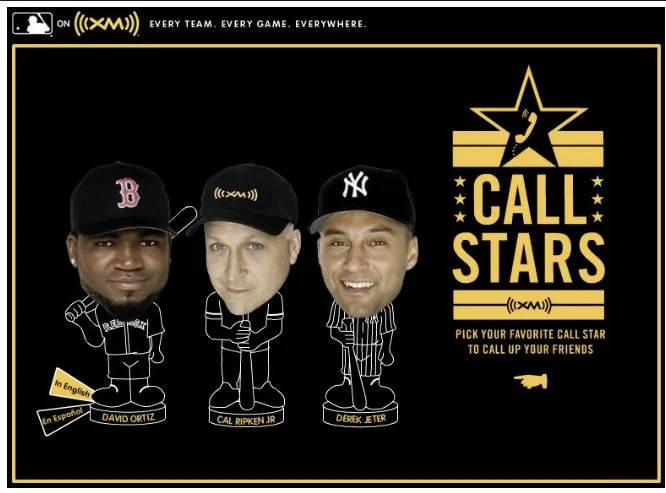innovation
xm radio “Call Stars”
Using viral influencer marketing To Drive awareness
Challenge
Raising awareness of XM radio content to drive subscriptions/customer growth with limited marketing budgets
Background
In 2005, XM Radio reached an agreement with Major League Baseball to pay $650M for the rights to broadcast every game. I was initially brought in by XM to market MLB content to drive user growth. My role expanded over time to include marketing the entire array of music, news, and sports programming assets at XM.
Our challenge was the programming arms race between XM and Sirius (lone competitors in the satellite radio market before their merger). The competition had led to rapidly escalating programming costs which ultimately translated into limited consumer marketing budgets.
Digging into consumer data and interviews, I uncovered big consumer insight that drove a new marketing approach I implemented. I realized that the most avid XM fans were those for whom XM filled an enormous programming void. For example, while there were many more pop and rock fans who listened to XM, the more loyal and committed customers were the country, jazz, and even classical music fans because they didn’t have access to those genres on traditional radio.
The most committed listeners of Major League Baseball games on XM followed a similar dynamic. The fans who couldn’t live without our baseball programming were not simply the biggest baseball fans, rather they were die-hard fans who lived in different cities than their allegiances. Thus, we targeted Red Sox fans in New York not in Boston, because they weren’t able to find Red Sox games on New York radio stations.
The tagline I created — MLB on XM. Every Team. Every Game — was hardly marketing genius. It was just the most straightforward way to communicate our value proposition to fans — that those games they always wanted to hear were now within their reach.
The challenge we faced was how to raise awareness. We had great assets (including relationships with future Hall of Fame Players, Derek Jeter, David Ortiz, and Cal Ripken), but lacked media budgets for a traditional marketing campaign that would reach our consumer target.
Solution
My corollary to the adage “Necessity is the mother of invention” is that “Constraints are drivers of innovation”. We had a game changing product for consumers, amazing influencers, but no meaningful budget.
I discovered a company that had developed technology where celebrities would voice a script that fans could customize and send to friends in the form of a phone call. The result was one could send to a friend a phone call personalized with details only a friend could know, yet seemingly from the celebrity..
I immediately recognized the application of such technology to a potential campaign for XM that would raise the awareness among baseball fans of our carrying every Major League Baseball game. What could be cooler to a baseball fan than receiving a personal call from one of their favorite players? And when I say famous, I mean Hall of Fame talent, Derek Jeter, David Ortiz, and Cal Ripken.
Creating this campaign was labor-intensive, so we had to move quickly. I worked closely with the tech providers to write scripts for each player that optimized user personalization (names, favorite team, hobbies, etc.) while promoting our “Every Team. Every Game.” tagline and value proposition. In addition, I set up three-hour in-studio recording sessions with each of the three players where they read scripts with all of the potential customization options.
We had little time to spare and rushed the technical development in order for the campaign launch at the beginning of the Major League Baseball season in early April 2007.
Here is how the “XM Call Stars” promotion worked: fans would visit an XM radio website where they could choose which player would make the phone call and then enter a friend's name, favorite team, hobbies, and other details. It was akin to a celebrity phone call version of “Mad Libs.” Users’ friends then received the personalized voice message on their phone, email or by AOL IM.
We promoted Call Stars on-air, reached out via email to our current subscribers to seed the campaign, and used existing digital inventory to roll-out online ads. It was a resource-scarce marketing campaign, but our hope was that the novelty and coolness of the idea coupled with an initial push to seed interest would ensure its effectiveness.
Results
For a baseball fan, getting a personal phone call from one of the three greatest baseball players was off-the-charts exciting. By initially seeding this with our XM listeners, we had a critical mass of fans who could make the campaign go viral. It took off like wildfire.
Within the first week, we had generated over a million interactions – personal calls to friends that delivered the “MLB on XM. Every Team. Every Game.” tagline. These calls raised awareness among die-hard baseball fans of XM’s unique value proposition, and the campaign was a smashing success.
The next year, 2008, I created a follow-up Call Stars campaign. Instead of using phone calls as a hook, we enabled fans to create digital bobblehead avatars. They could use personal photos and any MLB uniform to customize their avatars and share them with others (and magically transform their friends into bobbleheads). Additionally, we used a political campaign theme to tie into the excitement around the 2008 Presidential election and we made our Call Stars (Jeter and Ortiz) the candidates.
The new campaign also went viral, generating several hundred thousand interactions, proving again the power of constraints in driving creative innovation.

